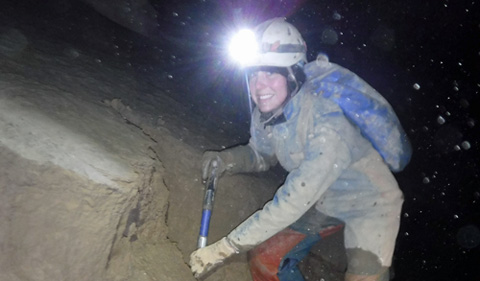
Kelli Baxstrom, first-year master’s student in Geological Sciences, digs floodwater sediment in Buckeye Creek Cave searching for charcoal.
By Kelli Baxstrom ’19
Geological Sciences M.S. Candidate
Every few weekends, Geological Sciences Chair Dr. Greg Springer and I travel to the West Virginia Association for Cave Studies near Lewisburg, WV, to go caving.
Although spending the weekend underground can be both fun and adventurous, our main objective is to collect data from cave sediments to help better understand climatic changes over the past 27,000 years.
The primary goal is to collect data for my M.S. thesis project. I trench flood sediments found in certain caves to look for organic material to radiocarbon date. I am searching specifically for charcoal, so that I can create a model of wildfire regimes (frequency and intensity of wildfires in an area during a time period) through the last 27,000 years and compare it to historic moisture levels in the Appalachian Mountains.
The fire regime model that will be developed in this project will provide a baseline for understanding how Appalachian fire regime changes with changing moisture levels. This information can be used as a tool for predicting wildfire regimes in Appalachia for the next few centuries of changing climate and moisture levels.
Though wildfires have been far more prevalent on the West Coast in recent years, wildfires on the East Coast are likely to impact large numbers of people if they increase in frequency and intensity. Fire suppression practices can make wildfires worse when land is not managed properly, and though land management agencies have plans for modern fire regimes, they will be able to use this research to amend future prescribed burning plans.
Dr. Springer has long conducted research on cave formation and cave identification and analyzed various types of climate data preserved in cave systems. Over the years he has introduced many Ohio University students to scientific analyses of cave systems.
“Caves can preserve evidence of past climates and landscapes for very long periods of time, which is not true on the surface,” he notes. “And caves are naturally intriguing to students, so visiting or working in caves is a great way to excite students about the geology they are studying here at Ohio University.”
Drew Hall, fellow M.S. student working in Dr. Springer’s research group, agreed.
“As an undergraduate student, I heard about Dr. Springer’s caving research and was immediately interested. When helping him survey new passages on my first real cave trip in Greenbrier County, West Virginia, I instantly fell in love with caving; something about exploring the darker regions of this Earth fascinated me. I started conducting research on cave scallops, a type of erosional features, to reconstruct a cave’s hydrogeologic history. I applied for graduate school at Ohio University so I could continue my research on caves,” Hall said.



















Comments